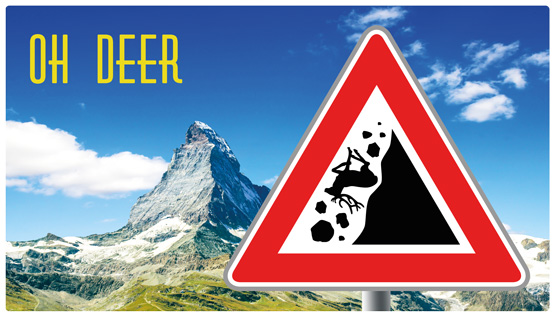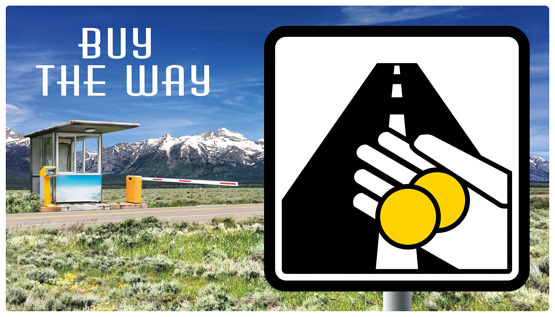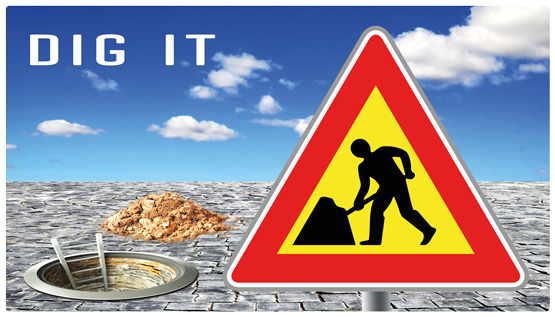Vintage 2018
The weather
Below graph shows maximum temperature (red curve in °C), minimum temperature (blue curve in °C) and precipitation (green bars in mm) between April and November.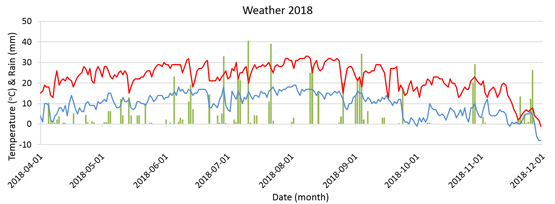
Specific for the vintage was:
- Rather few days the temperature exceeded 30 °C, which is beneficial for white grapes.
- There was big risk for night frost the 1st of October, which would have forced us to harvest within some days. But as usual, our steep vineyard was not affected.
- There was appropriate amount of rain during most of the season (not seldom our vineyards get too dry during growing season). Together with ideal temperature, the harvest time got one or two weeks earlier than normal.
- Some rain was lacking during the spring, but without long term problems.
- The abundant 100 mm rain from the 1st to the 7tn of September, cause gray rot to attack, which in most cases didn't convert to good botrytis.
- There was almost no rain from th 29th of September to the 27th of October, which made our harvest very comfortable for us, see a crazy weather report below.

Harvest and pressing
Sometimes you think you already have experience for everything what might come across. But over and over again you face new unforeseen circumstances. This vintage harvest was very different because of the long rain-free period, but of cause, this hindsight we had not from the beginning. The outcome was, that we harvested at three rather different time periods.
First round, normal harvest period
Due to emerging rot in Genesis low, and the fact that these grapes were decently ripe at the time, we decided to harvest as early as the 18th of September. We applied a severe selection, by discarding all bunches that had doubtful botrytis.
Gunnel and Christer Sandahl had not yet traveled to Badacsony, so Zsolt Palkó had to manage harvest and pressing. This was the first time we used our new Scharfenberger press, and we very soon found out, that the state of the art automatic docking mechanism didn't work at all. We had to revert to pressing with a traditionally tray, whereto the juice splashed down as usually to the tray from the drum.
Second round, late harvest period
Another problematic vineyard with a lot of intermixed gray rot was the Bishop Garden. The rot didn't develop to anything better, so we decided to harvest the 4th of September with extreme hard selection. When we pressed Bishop Garden, we were doubtful from the smell and tasted of the juice we obtained, and consequently we decided to not mix this with any other unproblematic juice, and consequently we mixed all Bishop Garden fractions together and added the 3rd fraction from Genesis low.
We found out that Bishop Backyard west and Solitude also begun to ripen. At that time we didn't know that the weather should remain perfect for another two weeks, so we decided to harvest the 5th of October. This harvest time was later than almost every neighbors, except for those planning for sweet desert wines.
Unlike Bishop Garden, the grapes we harvested from Bishop Backyard west and Solitude was perfect with some (about 10 %) good botrytis, apart from some vineyard corners where gray rot had taken over. Hard selection was again the standard method. The pressing went well and the juice tasted really crisp and elegant. Unusually much of the juice went to the 1st fraction.
Third round, ultra-late harvest period
The fine and rain-free weather continued day after day. We had some good botrytis (say 10 %) exposed in the remaining unharvested vineyards, with the vulnerable botrytis being over a month old, the slightest rain would have washed it away.
The leaves turned yellow, and the measurable sugar didn't rise, but the acidity did fall gradually. We didn't push the luck too much, and harvested the 15th and 17th of October. The grapes were phenomenal in quality, and pressing got to a beautiful song. Again, unusual big portion went to the 1st fraction.
Fermentation
So we ended up with the following nine tanks
- 2nd fraction from Genesis low normal harvest period the 2018-09-18
- 1st fraction from Genesis low normal harvest period the 2018-09-18
- 3rd fraction from Genesis low normal harvest period the 2018-09-18
+ 1st and 2nd fractions from Bishop Garden late harvest period 2018-10-04 - 1st fraction from Bishop Backyard west and Solitude late harvest period 2018-10-05
- 2nd fraction from Bishop Backyard west and Solitude late harvest period 2018-10-05
- 1st fraction from Genesis high and Genesis grafts west ultra-late harvest period 2018-10-15
- 1st fraction from Bishop backyard east, and Genesis high, and Genesis grafts west & east ultra-late harvest period 2018-10-17
- 2nd fractions from the two ultra-late harvest periods above 2018-10-15 and 2018-10-17
- 3rd fraction from the three late and ultra-late harvest periods above 2018-10-05, 2018-10-15 and 2018-10-17
As can be noted from above, despite the great harvest weather, we didn't succeed to harvest each vineyard separately. The cause to this was that we had to take into account the uneven distribution of gray rot, and (more positively) that we day after day postponed the harvest for those parts of the vineyards that developed excellently.
The fermentation was this vintage very easy to start. We just had to add some nutrients in the beginning to avoid sulfur-hydrogen to emerge.
Breaking fermentation
The 2018 vintage created "classic" wines. That means moderate alcohol, around 13 %, balanced acidity, 6 gram/liter, volatile acidity around 0.3 gram/liter, and no malolactic fermentation. To create balance to the acidity and alcohol, we decided a sugar of 6 gram/liter for the better wines and 8 gram/liter for our entry wines.
Assembling the wines
When the basic racking was done on all finished wines, we met in beginning of May to assemble the tanks into a Sandahl 2018 wine portfolio. We had the tanks as listed above. Our intention was to assemble the tanks to one 'Solid ground' wine, one 'Mid range' wine and several 'Rare peak' wines. To assemble the 'Solid ground' wine was rather simple, like:
Solid ground grade level (white Sandahl text on black screw cap) :
Solid ground grade: Tank 3
Mid Range grade level (white Sandahl text on black cork capsule) :
As we worked through some alternatives of assembling remaining tanks, we could not avoid to end up with two rather different 'Mid range' wines, the ordinary we called 'Mid range plain' and the better we called 'Mid range plus'
Mid range plain grade: Tank 1 + tank 5
Mid range plus grade: Tank 2 + tank 8
Rare Peak grade level (golden Sandahl text on black cork capsule) :
It was also rather simple to assemble the 'Rare peak' wines, these origins from the 1st fraction of the 'late harvest' and 'ultra late harvest'. As seen below, we had actually two tanks of 'ultra late harvest', but these were too similar to not mix them together.
Rare peak grade late harvest: Tank 4
Rare peak grade ultra-late harvest: Tank 6 + tank 7
Bottling
Bottling has been done in end of July. We used the traditional green high bottle for 750 ml content.
Label theme
The first alternative to 2018 labels we picked a 'renovation' theme, because we have renovated our house for several years, living in a building mess, and several times been cleaning the house from ubiquitous dust coatings.
However, when we started our market campaign, we divided our wine portfolio into the three grades presented above, and we found out pictures to illustrate each grade. The 'Rare peak' became illustrated by the Matterhorn mountain, the 'Mid range' grade by a mountain range, and solid ground by a stone paved surface.
So, finally the theme was decided to be a road sign for each wine, useful in the three different grade illustrations.
Capsules
To easier distinguish between the three grades, we also designed the capsules different from each other.
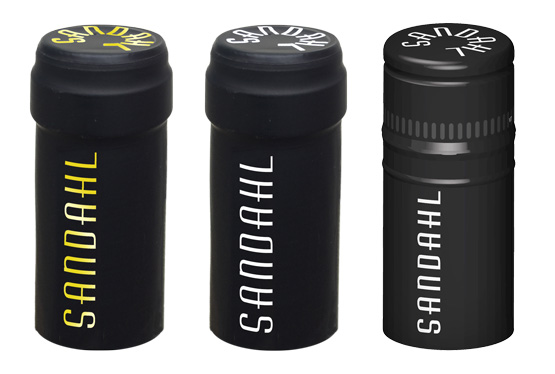
Rare Peak |
Mid Range |
Solid ground |
Labels
To support introduction of the different grades Rare Peak, Mid Range, and Solid Ground, we simply made the front labels using image of these concepts as backgrounds. And just as simple, in the front we put in a traffic sign.
2018 Badacsony Riesling Rare peak ultra late harvest 'Oh deer'
Being upset when warned for a falling deer.
Link for more details (leads to the same site as the link fom the the QR code at the back label).
2018 Badacsony Riesling Rare peak late harvest 'Sign up'
Traffic sign reminding of time to order some bottles.
Link for more details (leads to the same site as the link fom the the QR code at the back label).
2018 Badacsony Riesling Mid range plus 'Not yet'
At the time of label design, we didn't know how true this should get.
Link for more details (leads to the same site as the link fom the the QR code at the back label).
2018 Badacsony Riesling Mid range plain 'Buy the road'
If you bring no coins, try a grander solution.
Link for more details (leads to the same site as the link fom the the QR code at the back label).
2018 Badacsony Riesling Solid ground 'Dig it'
We have nothing ourselves below our solid ground wines.
Link for more details (leads to the same site as the link fom the the QR code at the back label).
Link to an explanation how to dig bottles of Dig it.


